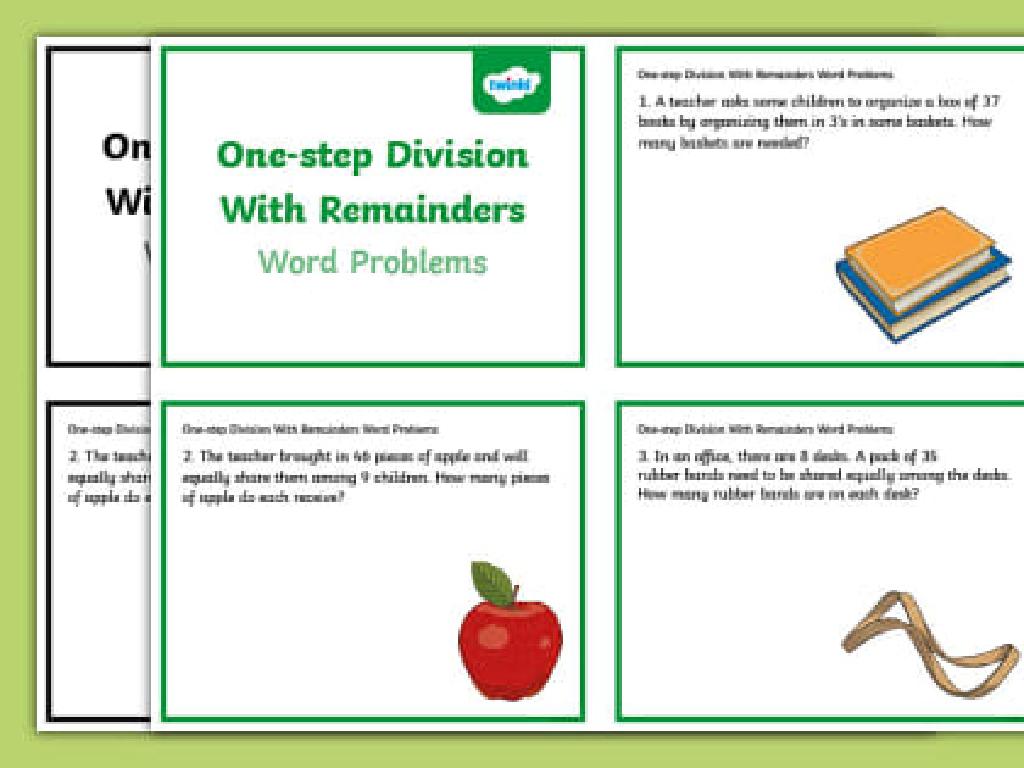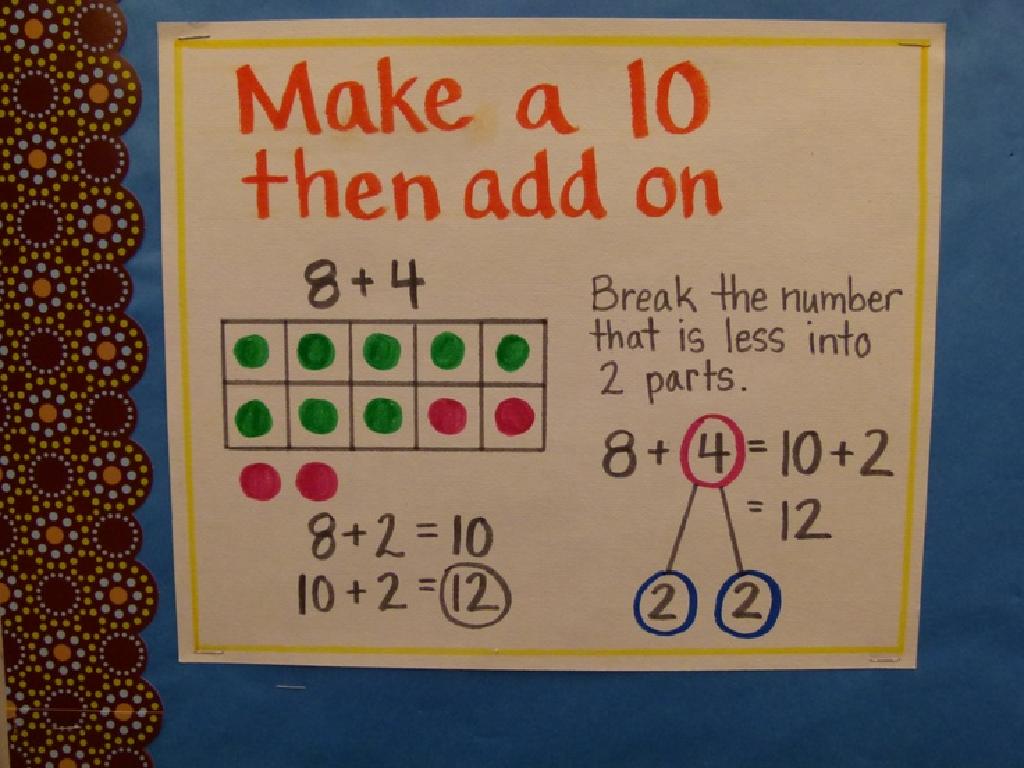Understanding Exponents
Subject: Math
Grade: Eighth grade
Topic: Exponents
Please LOG IN to download the presentation. Access is available to registered users only.
View More Content
Welcome to Exponents!
– Grasping the concept of exponents
– Exponents are a way to express repeated multiplication of the same number.
– Exponents in daily scenarios
– Calculating compound interest, understanding computer storage, and population growth.
– Exponents signify repeated multiplication
– For example, 3^4 means 3 multiplied by itself 4 times: 3 x 3 x 3 x 3.
– The ‘power’ represents the number of times
– In 2^5, ‘2’ is the base and ‘5’ is the exponent or power, indicating 2 is used as a factor 5 times.
|
This slide introduces students to the concept of exponents, a fundamental component of algebra and higher-level mathematics. Begin by explaining that exponents are a shorthand notation for expressing how many times a number, known as the base, is multiplied by itself. Highlight how exponents are encountered in real-life situations such as calculating interest rates or understanding how computer memory is measured. Emphasize the ‘power’ aspect by showing that the exponent number represents the count of multiplication. Provide examples to illustrate this point and encourage students to think of other scenarios where exponents might be applicable. This will help them see the relevance of exponents beyond the classroom.
Understanding Exponents
– Define an exponent
– An exponent represents repeated multiplication of a number
– Exponent components: base and power
– Base: the number being multiplied; Power: the number of times it’s multiplied
– How to read exponents aloud
– Say the base followed by ‘to the power of’ the exponent
– Practice with examples
– For instance, 3^2 is read as ‘three to the second power’ or simply ‘three squared’
|
This slide introduces the concept of exponents, which are a fundamental part of algebra and used to express repeated multiplication. It’s crucial for students to understand the two parts of an exponent: the base, which is the number being multiplied, and the power, which indicates how many times the base is used as a factor. Emphasize the correct way to read exponents aloud, as this will help students communicate mathematical ideas more effectively. Provide examples such as 2^3 (two to the third power) and 5^4 (five to the fourth power) for practice. Encourage students to create their own examples and read them aloud to reinforce their understanding.
Working with Exponents
– Simplify expressions with exponents
– Combine like terms using exponent rules
– Product of Powers rule
– Multiply same bases, add exponents: a^m * a^n = a^(m+n)
– Power of a Power rule
– Raising a power to a power, multiply exponents: (a^m)^n = a^(m*n)
– Practice with exponent rules
|
This slide introduces students to the fundamental rules of working with exponents. Start by explaining how to simplify expressions that contain exponents by combining like terms. Then, delve into the specific rules such as the Product of Powers, which states that when multiplying two exponents with the same base, you add the exponents. Follow with the Power of a Power rule, which teaches that when taking an exponent to another power, you multiply the exponents. Provide examples for each rule and encourage students to solve similar problems to reinforce their understanding. End the lesson with practice problems that require students to apply both rules, ensuring they grasp the concepts.
Zero and Negative Exponents
– Zero exponent rule
– Any number raised to the power of zero is 1, e.g., 5^0 = 1
– Negative exponent meaning
– A negative exponent represents a reciprocal, e.g., 2^-1 = 1/2
– Examples with zero exponents
– 10^0 = 1, 100^0 = 1, (1/3)^0 = 1
– Examples with negative exponents
– 3^-2 = 1/3^2 = 1/9, (1/5)^-1 = 5
|
This slide introduces students to the concept of zero and negative exponents. Begin by explaining that any non-zero number raised to the power of zero equals one, which is known as the zero exponent rule. Then, discuss negative exponents and how they represent the reciprocal of the base raised to the positive exponent. Provide clear examples to illustrate both concepts. For zero exponents, use a variety of bases, including fractions, to show that the rule applies universally. For negative exponents, demonstrate how the negative sign indicates a ‘flipping’ of the fraction. Encourage students to practice with additional examples and to consider how these rules apply to simplifying expressions.
Exponential Growth and Decay
– Examples of exponential growth
– Populations, investments grow rapidly over time
– Examples of exponential decay
– Radioactive substances decrease in amount over time
– How to graph exponential functions
– Plotting points on a graph shows the rate of increase or decrease
|
This slide introduces students to the concepts of exponential growth and decay, with real-life examples to help them understand the practical applications. Exponential growth can be seen in scenarios where quantities increase rapidly over time, such as bacterial populations or investments with compound interest. Exponential decay, on the other hand, occurs in processes where quantities decrease rapidly, such as the decay of radioactive substances. Students will also learn the basics of graphing exponential functions, which is a visual representation of these concepts. Emphasize the ‘J-shaped’ curve for growth and a ‘decreasing curve’ for decay. Encourage students to think of other examples they may have encountered in their lives.
Class Activity: Exponent Bingo
– Engage in Exponent Bingo game
– Solve exponent problems on card
– Use laws of exponents to solve
– Aim to complete a row first
– Shout ‘Bingo!’ when done
|
This interactive class activity is designed to help students practice their understanding of exponents in a fun and engaging way. Prepare Bingo cards with different exponent problems in each square. Students will solve these problems and mark off the squares on their Bingo cards. The first student to complete a row (horizontal, vertical, or diagonal) should shout ‘Bingo!’ and present their solutions to the class. As a teacher, be ready to provide a quick review of exponent rules before starting the game. Possible variations of the activity could include having different difficulty levels, using exponent problems that require simplification, or having students create their own Bingo cards with problems for their peers to solve.
Homework and Further Practice: Mastering Exponents
– Complete the exponent worksheet
– Apply exponents in real-life
– For example, calculate compound interest or population growth
– Get ready for the exponent quiz
– Review notes and ask questions
– Review class notes and clarify doubts before the quiz
|
This slide outlines the homework and additional practice activities for students to reinforce their understanding of exponents. The worksheet provided will contain a variety of problems, ensuring students practice computing powers and understanding the laws of exponents. Encourage students to apply exponents in real-world contexts, such as calculating compound interest or predicting population growth, to appreciate the practical applications of what they’ve learned. Remind them that the upcoming quiz will assess their comprehension of exponents, so they should review their notes thoroughly and reach out with any questions they might have during the next class. This will help solidify their grasp on the topic and prepare them for more advanced mathematical concepts.






